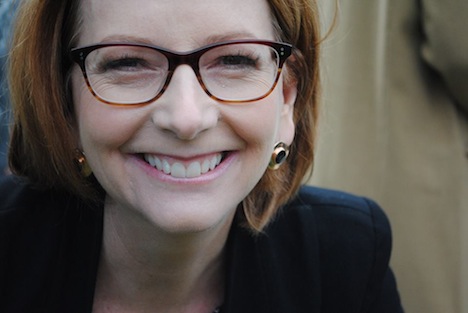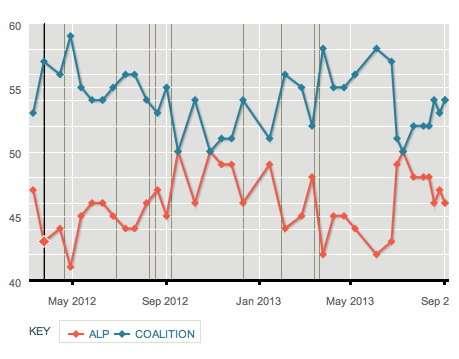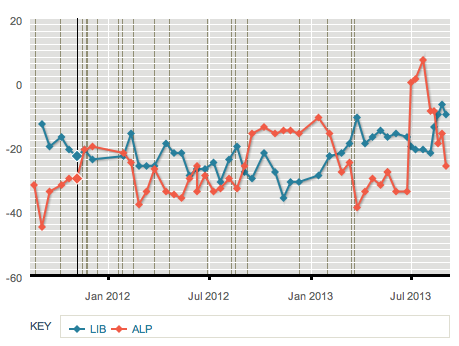It’s now election day (Sydney time) in Australia, and if polls are correct, the Australian Labor Party is headed for a staggering defeat, despite the fact that Labor MPs deposed prime minister Julia Gillard three months ago in order to bring back Kevin Rudd, prime minister from 2007 to 2010.![]()
When she lost the Labor leadership, Gillard announced her retirement from politics, noting that she wouldn’t stand for reelection in the Lalor seat she’s held in southwestern Melbourne in Victoria state since 1998. Gillard has been completely absent from the campaign trail, ostensibly to cede the spotlight to Rudd (and more importantly, avoid the kind of anonymous sniping that marked Rudd’s shadow campaign to unseat Gillard), who won the June 2013 leadership spill with the support of 57 MPs to just 45 MPs supporting Gillard.
But the final Newspoll survey shows that once the two-party preferred vote is distributed, Labor will win just 46% of the vote to 54% for the center-right Coalition government dominated by the Liberal Party (with the National Party). If that poll is accurate, it means that Rudd is headed for a disaster on par with the worst Labor result of the past 35 years. In the March 1996 election, John Howard led the Coalition to power while prime minister Paul Keating won just 49 seats — and 49 is the number everyone will be watching as results come in on a night that is expected to be grim either way for Rudd.
That prospect has led several figures prominent Labor voices to argue that the party should have stuck with Gillard through the election. A look at the polling data throughout 2012 and 2013 doesn’t necessarily back that conclusion, though:
Gillard’s prospects had been in decline throughout the entirety of 2013 and when Rudd finally reclaimed the leadership, Labor was headed to an even more drastic defeat that it faces today, with some polls showing a 58-42 Coalition landslide victory. Gillard had a rough year. In January, she announced that September 14 would be the election date, consigning Australia to an essentially nine-month election campaign. In March, she faced the first of two leadership spills from Rudd’s supporters (Rudd decided not to stand for the leadership in the March vote, but obviously stood in the June spill, despite the fact that he pledged not to challenge Gillard again until after the 2013 election). In May, former treasurer Wayne Swan announced an unexpected budget deficit that added to Labor’s woes.
Polls also show Gillard’s relatively unpopularity:
Australian voters don’t particularly care for Coalition/Liberal leader Tony Abbott, but they soured on Gillard in early 2013 and never looked back. Ironically, though Rudd had a positive approval rating when he returned as prime minister in July, his approval ratings have plummeted as the election approached, and he’s doing almost as poorly as Gillard was in June. Meanwhile, Abbott has succeeded in winning some begrudging admiration from voters after four years as opposition leader.
There’s no way to know that Gillard would or would not have recovered, though it seems unlikely that Labor would have actually finished with just 42% of the two-party preferred vote, no matter what June’s polling data recorded. That doesn’t mean that Labor’s decision to bring back Rudd was a great idea. Hindsight is, of course, 20-20, but here are five reasons why Labor might have wished it stuck with Gillard instead:
1. The decision to remove Gillard made Labor look irresponsible. Rudd himself suffered a leadership purge in June 2010 when then-deputy prime minister Gillard came to power, and voters punished Labor in the resulting August 2010 election for putting internal leadership battles over governing. Labor returned to power with only the narrowest of margins, which depended upon support from independent and Australian Green Party MPs. But throughout the 2010 campaign and thereafter, Rudd and his supporters never fully stopped briefing against Gillard. Despite the fact that Gillard appointed Rudd as her foreign minister, Rudd challenged for the leadership again in February 2012 (and lost) before returning this summer. If you’re keeping track, that’s four leadership spills and two changes of prime minister (with accompanying frontbench swaps of the government’s top ministers) in the span of just six years. If Labor suffers a landslide defeat on Saturday, it won’t because Australian voters have been swept off their feet by Abbott or even that they disagree with Labor’s policies — it’s because voters are tired of the Gillard-Rudd dueling and a Labor government that seems irresponsible.
2. Rudd’s bounce was inevitably going to fizzle. The high mark of the Rudd restoration came shortly after he returned to the Lodge — polls showed Labor and the Coalition tied 50-50 in early July. It’s been all downhill from there, but even as recently as August, voters preferred Rudd as prime minister by a double-digit margin. Remarkably, they now narrowly prefer Abbott as prime minister. After years of expectations that Rudd (conveniently on the sidelines of most Labor policymaking decisions) would magically transform Labor’s problems, it was inevitable that Rudd’s popularity would come back down to earth when faced with the nuts and bolts of government — i.e., implementing a controversial new policy for asylum seekers.
3. Rudd in 2013 was never going to recapture the ‘Kevin07’ magic. Very few politicians recapture the magic that captivates voters during their first successful run for office — in the United States, think about the excitement surrounding George W. Bush in 2000 and Barack Obama in 2008 (and the relative lack of enthusiasm they inspired in their respective 2004 and 2012 reelection campaigns). When Rudd came to power six years ago, he was a new face from a new generation ready to deliver the final blow to John Howard’s 11-year-old government. The dynamic in 2013 was never going to be the same. Rudd demonstrated much of the quirky, down-to-earth charm that he’s always had as opposition leader, as prime minister, as foreign minister and once again prime minister. But that doesn’t mean he has a magic talisman that can simply deliver election victories.
4. Gillard actually passed the mining tax and carbon scheme. Though Rudd swept to power with promises to pass a mining ‘superprofits’ tax and a carbon pricing scheme, his failure to do so was one of the substantive reasons that Australian voters and Labor MPs had soured on Rudd by June 2010. But after winning her own mandate, Gillard set to work in passing both policy priorities, which came into effect in summer 2012. Given that Abbott has campaigned hard on repealing both of them, you can think of the 2013 election, in large part, as a referendum on the carbon scheme and the mining tax. If that’s the case, perhaps it would have been better to have Gillard defending her two major policy victories. In any event, decapitating the Gillard government doesn’t mean that a Rudd-led campaign wouldn’t have to campaign on Gillard’s accomplishments.
5. Winning Australian women. One of Gillard’s strongest points was her appeal to women as Australia’s first female prime minister, especially after delivering a stinging anti-misogyny speech in the House of Representatives last October that left Abbott and the entire opposition on the defensive. What if women were willing to give Gillard a second look? After all, Abbott will arguably be the most anti-abortion prime minister in Australian history, despite the fact that huge majorities of both men and women oppose abortion restrictions. Meanwhile, though Rudd was expected to boost Labor’s result in his home state of Queensland, Rudd faces the prospect of losing his own Griffth seat among many others there.



2 thoughts on “Five reasons why Australian Labor should have stuck with Julia Gillard”